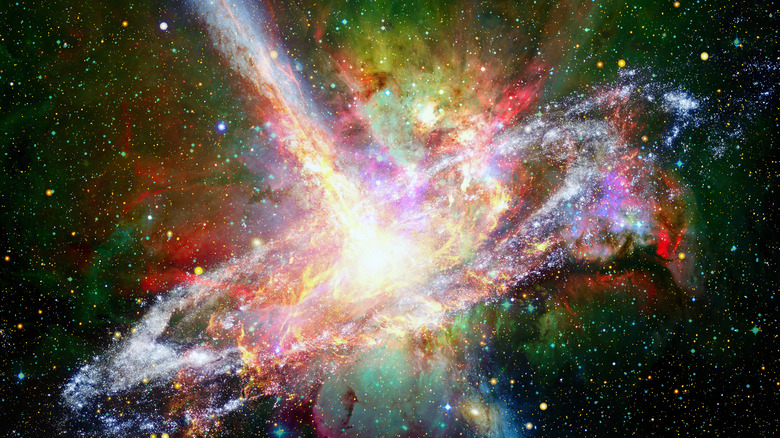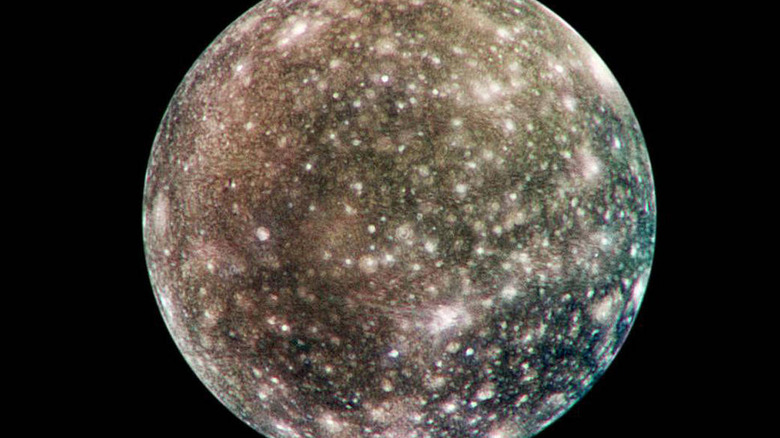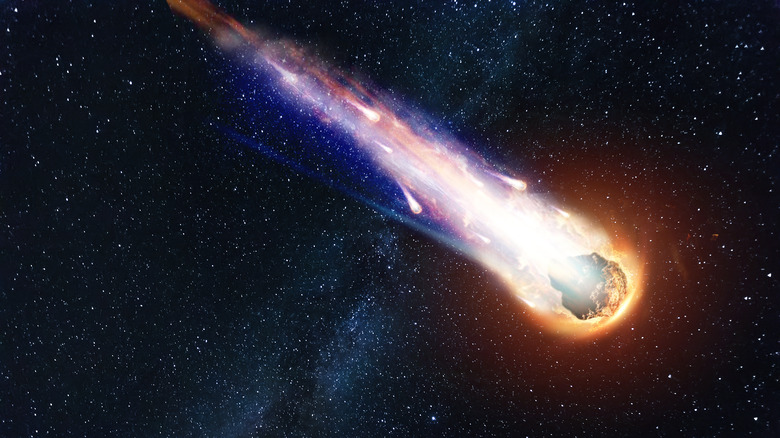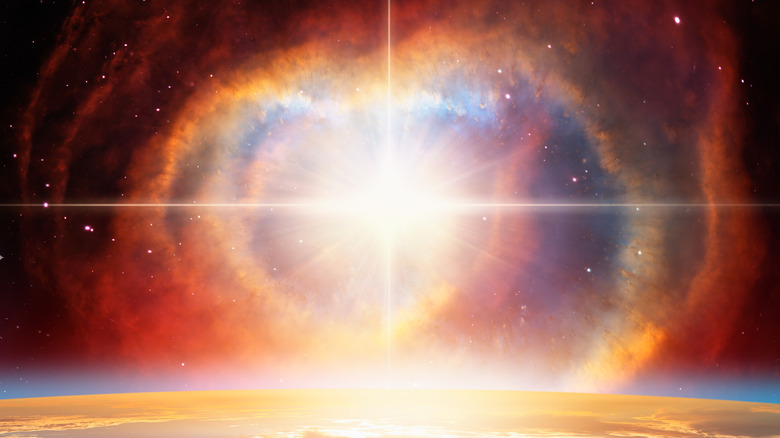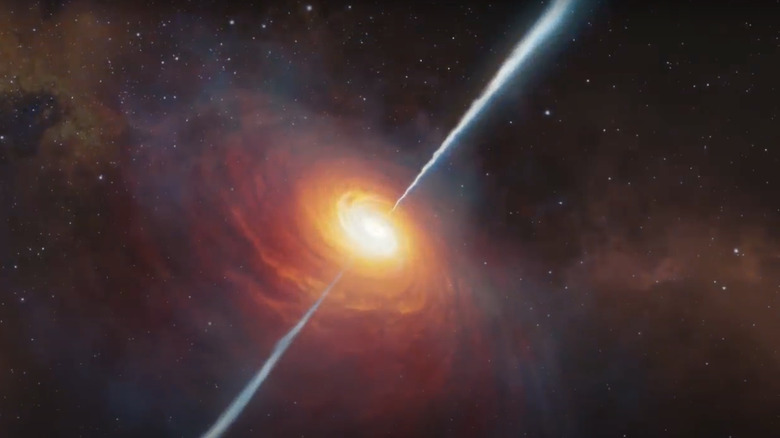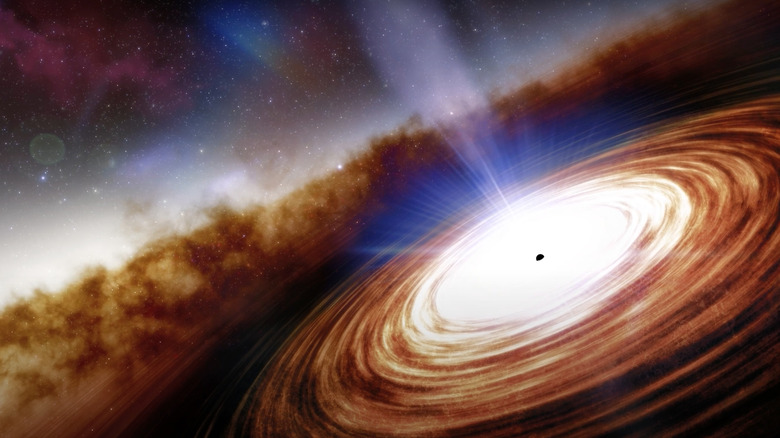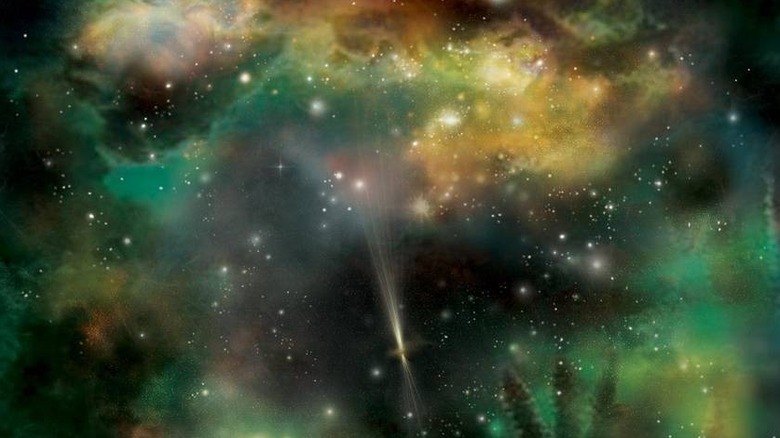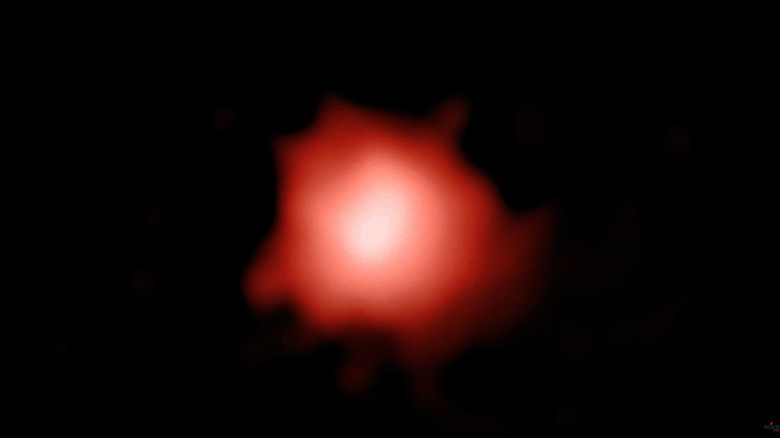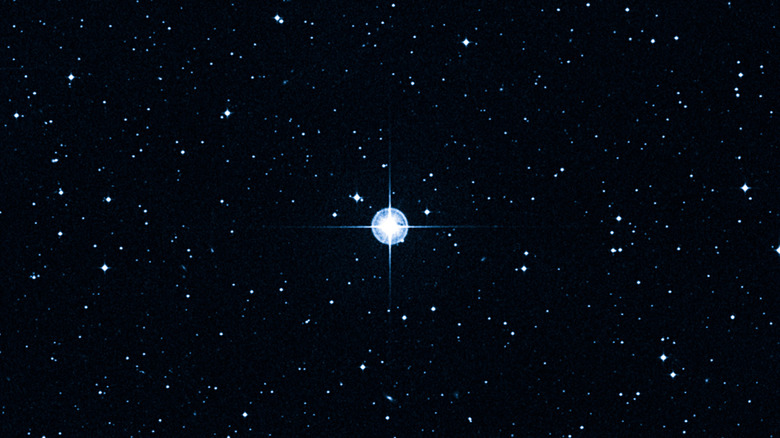These Ancient Objects Are Some Of The Oldest In The Universe
Some objects in space make it seem as if dinosaurs were roaming around yesterday. Take the two primeval galaxies that the James Webb Space Telescope just observed. The furthest is 13.4 billion light years out, the other not far behind.
The thing about such objects is that we are seeing them as they were back then, because their light took just as many billions of years to traverse the void and make it over here. We are also seeing them at their youngest. If you could teleport and try to make out Earth from a telescope on the other side, you would see a much younger planet. If you traveled far enough, deep into the abyss of the cosmos, you would see nothing at all. Earth had not yet formed so soon after the universe exploded into being.
Almost anything that spawned so far back in time can give away its age through redshift and blueshift. Wavelengths of light grow shorter towards the blue side (such as ultraviolet) and longer towards the red side (like infrared). When something is billions of light years away, according to ESA, the wavelengths of its light will stretch as they trek further and further through space. This is redshift — a shifting of light towards the red end of the spectrum. Each of the cosmic time capsules below (with the exception of the meteorite that fell to Earth) is the oldest of its kind known to exist in the entire universe, until more show up.
Pulsar J0108-1431
Though pulsars (neutron stars that spin ridiculously fast) don't "live" very long — think hundreds of millions of years instead of billions — this one has outlived them all. NASA found J0108-1431 to be the oldest pulsar ever observed in X-rays. Discovered through the Chandra Observatory in 2009, the 200-million-year-old flashing orb turned out to be not only ancient, but still kicking. Pulsars are hardcore. Like all neutron stars, they are made of some of the densest stuff possible, but add superfast rotation to that and you have a cosmic carnival ride. They flash with each revolution. These bursts of light help astronomers observe them.
After this pulsar was observed again by the Hubble Space Telescope and Very Large Telescope, a team of scientists found that it wasn't a loner as it was previously thought to be, as they wrote in a study published in The Astrophysical Journal. Something showed up that they believed to be a younger pulsar that they considered its "counerpart."
Since J0108-1431 appears to us in its twilight years, it is a faint pulsar that had slowed down from the breakneck speeds it was once thought to spin at. The light that was reaching us was first generated 200 million years ago. For all Earthlings know, it could have bit the dust eons ago. There is no way to know if it is actually "alive" right now unless we wait another 200 million years.
Callisto
Until someone can find a legit exomoon somewhere outside our solar system, Jupiter's satellite Callisto will remain the oldest known moon both in the solar system and the universe.
Callisto appeared pretty unglamorous when it was first observed. NASA sees this rocky world as frozen over with ice and pockmarked with craters, meaning it has taken a beating from random flying objects over and over again from the 4 billion years it has been around. That is about how long ago Earth — and Jupiter — also formed. Though no samples have been brought back to prove this, Callisto and the other Jovian moons probably formed when debris left over after Jupiter was born. It surface may be scarred, but that is 4 billion years of asteroids, comets, and other projectiles leaving their mark. These craters have hardly eroded. Because of this, it is also unlikely there are any volcanoes on this moon.
Something made Callisto more interesting when NASA's Galileo spacecraft got a closeup in the 1990s. Observations from the orbiter indicated that there might be an ocean deep below all that rock and ice. Whether there actually is one is up for debate. Later observations found that if this subsurface ocean is for real, it is probably deeper than previously assumed. That said, there may be none at all. ESA's Jupiter Icy moons Explorer (JUICE) will be taking off for Callisto, Ganymede, and Europa in 2023, though, according to their website, so it might find out.
Meteorite Erg Chech 002
Earth is around 4.5 billion years old, the age that NASA puts it at. There is a meteorite fragment that plummeted to Earth which is even older than the land it crashed into.
Erg Chech 002 or EC 002 was discovered in May of 2020, according to data gathered by the Meteoritical Society. It was during the height of the pandemic that a scattering of coarse rocks embedded with green crystals surfaced from the sands of Algeria. Some were then purchased by scientists in Morocco. Further study revealed that they are igneous rocks, which were formed from volcanic activity on whatever object they were once part of (sometimes asteroids and meteors break off from much larger planets and moons) or another body it collided with in space.
In a 2021 study published in PNAS, scientists analyzed a shard of this meteorite up close and determined that it was nearly 4.6 billion years old. That is slightly older than our planet. Because it is an igneous rock, they also believe it is the oldest piece of hardened lava that has ever been found, and its given age is the age at which it is thought to have crystallized. When and for how long this meteorite existed as melted magma remains unknown. The scientists think that, based on the density of EC 002, that it took approximately 100,000 years to cool down. It was possibly part of a protoplanet that didn't make it.
Supernova DES16C2nm
The last death throes of a massive star explode into a spectacular finale also known as a supernova. Some of these stellar corpses are so brilliant, their light can almost transcend time.
After the Dark Energy Survey discovered that the light from supernova DES16C2nm had travelled 10.5 billion years to reach our planet, according to the University of Southampton, it's been the oldest version of this phenomenon that has ever been seen from Earth. The blast erupted so long ago that the universe was only a quarter of the age it is now. Now think about it. The universe is 13.8 billion years old, so cosmically speaking, a star blew up rather soon after the first stars began to form.
Not long after the supernova to end all ancient supernovas was discovered, a study that was published in The Astrophysical Journal revealed that DES16C2nm is not just any supernova. It was found to be a rare superluminous supernova, one of the brightest ones in existence. These can have up to a hundred times more luminosity than other supernovas. Gargantuan stars that explode at death can also reveal more about what the star was like when it was alive. The investigating scientists who analyzed this supernova were able to find out what metals were in the star before and after its demise. "The enormous luminosity of these events means that it is theoretically possible to discover and monitor them [extensively]," the scientists said.
Planet PSR B12620-26 b
Not all planets are created equal. Not all planets were created at the same time, either. Thought to be 13 billion years old, according to NASA, PSR B12620-26 b was seen by Hubble in 2003. It is more than twice Earth's age and 2.5 times the mass of Jupiter (that's 318 Earth masses). Each year on this gaseous orb is a hundred Earth years because it takes that long to orbit its star. Partly because of its discovery, the first planets are now thought to have emerged within only a billion years of the Big Bang, and compared to that, Earth and its solar system clique are still growing up. Finding a planet like this was also a huge deal because it might mean that there are many more planets floating around than we could ever imagine.
PSR B12620-26 b spawned in a really crowded globular star cluster in the constellation Scorpius. These types of clusters are usually low in heavier elements since they supposedly formed right after the universe yawned awake. Because the stars in them didn't really have a chance to fuse lighter atoms into heavier ones, that deficiency was thought to be detrimental to planet formation, but it turned out that embryonic planets can still use whatever scraps are around.
Among 100,000 stars, as NASA says, PSR B12620-26 orbits a mostly dead white dwarf star and a whirling neutron star. Talk about survival.
Quasar P172+18
Quasars (quasi-stellar radio sources) are some of the brightest and most monstrous objects in the universe, not to mention some of the oldest. NASA defines these objects as active supermassive black holes millions to billions of times the mass of the Sun. Black holes that are active "devour" anything that comes too close and belch out huge jets of plasma and radio emissions after a meal.
Many quasars are so ancient, the space agency wants to aim the eye of its James Webb Space Telescope at them to learn more about the universe in its infancy. Scientists who imaged this quasar and published a study in The Astronomical Journal believe it could have more secrets to spill about the early universe. "Quasars with billion-solar-mass black holes have been detected well within the epoch of reionization, when the universe was less than [1 billion years] old," they said.
Not only is P172+18 a leviathan of the sky, but it's spitting out radio emissions from 13 billion light years away, according to the Carnegie Institution for Science. It was born just 780 million years after the Big Bang. That makes it the oldest known quasar that is also giving off intensely luminous radio emissions. This object gives off the energy of 580 Milky Ways (that would be our galaxy and not the chocolate bar). It also qualifies as one of the supermassive black holes that is growing more supermassive the fastest.
Quasar J0313-1806
Just when you thought nothing was scarier than gaping black holes that live almost forever, this is thought to be not just the oldest quasar vomiting radio waves, but the oldest quasar (and black hole by default), period. Quasar J0313-1806 had to have been born huge. As Smithsonian Magazine reveals, this beast is thought to have started out at 10,000 times the mass of our Sun only 670 million years after the birth of the universe.
But it's also worth noting that black holes are not actually visible. Their gravity is much too powerful for even light to escape its deathgrip. It is the light around them, given off by the dismembered stars and other matter that they feed on, which can be detected, and information about the outflows of light they release into space can also be picked up by telescopes. That is how this quasar was detected after its light took over 13 billion years to make it to Earth. Sunlight is weak when you put it up against light 10 trillion times brighter, and it still took that long. Just imagine how far away that is.
In a study published in The Astrophysical Journal Letters, scientists say objects like J0313-1806 could give us an unprecedented look at how supermassive black holes originated and became the behemoths they were destined to morph into. Its unbelievably fast outflows may also shed more light on how new stars form from that vomitus.
Gamma-ray burst GRB 090423
When stars die, they don't just disappear. Their remnants can be scattered across the vacuum of space indefinitely.
13.1 billion years ago, when the universe was only 630 million years old, a star met its end. NASA reports it released gobs of gamma rays. This gamma-ray burst was caught by the space agency's Swift satellite, which had to switch the wavelengths of light it was viewing in to find out where exactly it was. (This would have been impossible to see in the light human eyes can handle, after all.) Gamma-ray bursts this far away are elusive, but they heat up otherwise invisible gases leaking out of the dead star and create an afterglow visible to a telescope in many wavelengths. Swift took advantage of that.
Given that, gamma-ray bursts can be some of the brightest phenomena in the universe. They happen when monstrous stars sputter to a halt and collapse in on themselves. What is left of them will eventually become a black hole or neutron star, and as this decomposition process happens, a blast of gamma rays is unleashed. What exactly is behind these outbursts is still unknown. GRB 090423 is still the furthest known explosion, though. For a long time, nothing further out would be seen, according to Sky & Telescope, though the James Webb Space Telescope's observations would go on to smash that record.
Galaxy GLASS-z13
The James Webb Space Telescope (JWST) recently spotted this galaxy at 13.4 billion light years away, meaning that we're seeing it as it was when the universe was only 300 million years old. GLASS-z13 is the furthest galaxy (and thus oldest) that have been confirmed so far. Before these discoveries, the furthest known galaxy (GLASS-z11) had formed 400 million years into the life of the universe. Light from when these galaxies first formed has had to stretch for almost unfathomable distances to get here, according to EarthSky. Then you have to remember that the universe has been expanding nonstop since the Big Bang, so the light from extremely distant objects not only has to travel for ages, but is stretched out more and more over time, so its sources are even further from Earth.
Speaking of extremes, these galaxies are also incredibly bright, as scientists who recently posted a study to the preprint server arXiv found out. "[This discovery] suggests that future deep JWST observations may identify relatively bright galaxies to much earlier epochs than might have been anticipated," they said.
Methuselah
Once thought to be older than the universe — a staggering 16 billion years old, compared to the universe's 13.8 billion year age — Methuselah, also known as HD 140283, still gets tens of billions of birthday candles and might be as old as the universe.
Wait. What? Could stars have really started shining the moment the universe began to exist? If the star Methuselah is older than the universe, then, as Forbes reports, it could turn the Big Bang theory on its head. This glowing orb is only 200 light years away, making it an object whose distance doesn't betray its age. What does is the stuff inside it. Its low amount of heavier elements means it formed when the universe was mostly hydrogen and helium, but the Big Bang isn't going anywhere yet.
Methuselah is a mystery that scientists are still confounded by, according to NASA. What is known for sure is that it is the oldest star that has ever been observed. Whether it is the oldest object in the universe remains to be seen, and while it is probably not 16 billion years old, it could be up to 14.5 billion, give or take 800 million years. It is also possible that something about the star has not been completely cleared up. It could be that the distance is off, or the physics are wrong, or the issue is something else entirely.
The cosmic microwave background
Is it an object? A phenomenon? Both? Either way, the cosmic microwave background (CMB) is leftover radiation from the nascent universe that is technically the oldest thing out there.
As NASA says, the universe is believed to have been overflowing with scorching hot gas when it first formed. This probably happened within the first hundred thousand years of its existence. With expansion, that gas began to cool, and as it continues to expand, it continues to cool (no wonder space is freezing). Leftover microwave radiation from the Big Bang is still hanging around like cosmic afterbirth, though. It's also everywhere, and if we could see it, the night sky would light up with enormous webs of light that appear brighter in some places and fainter in others.
It is ESA's Planck spacecraft that really zeroed in on the CMB to determine where the areas of highest and lowest energy are now. But when the universe was young, light could not travel long distances. As it began to expand outward and cooled, it became less dense, with more room for light to shine through. These observations of the CMB can tell us how the universe is expanding. But until we find something other relic from the cosmic dawn, this is the furthest back in time we can go — for now, at least.

